Charles E W Bean, Diaries, AWM38 3DRL 606/63/1 - October - November 1916 - Part 6
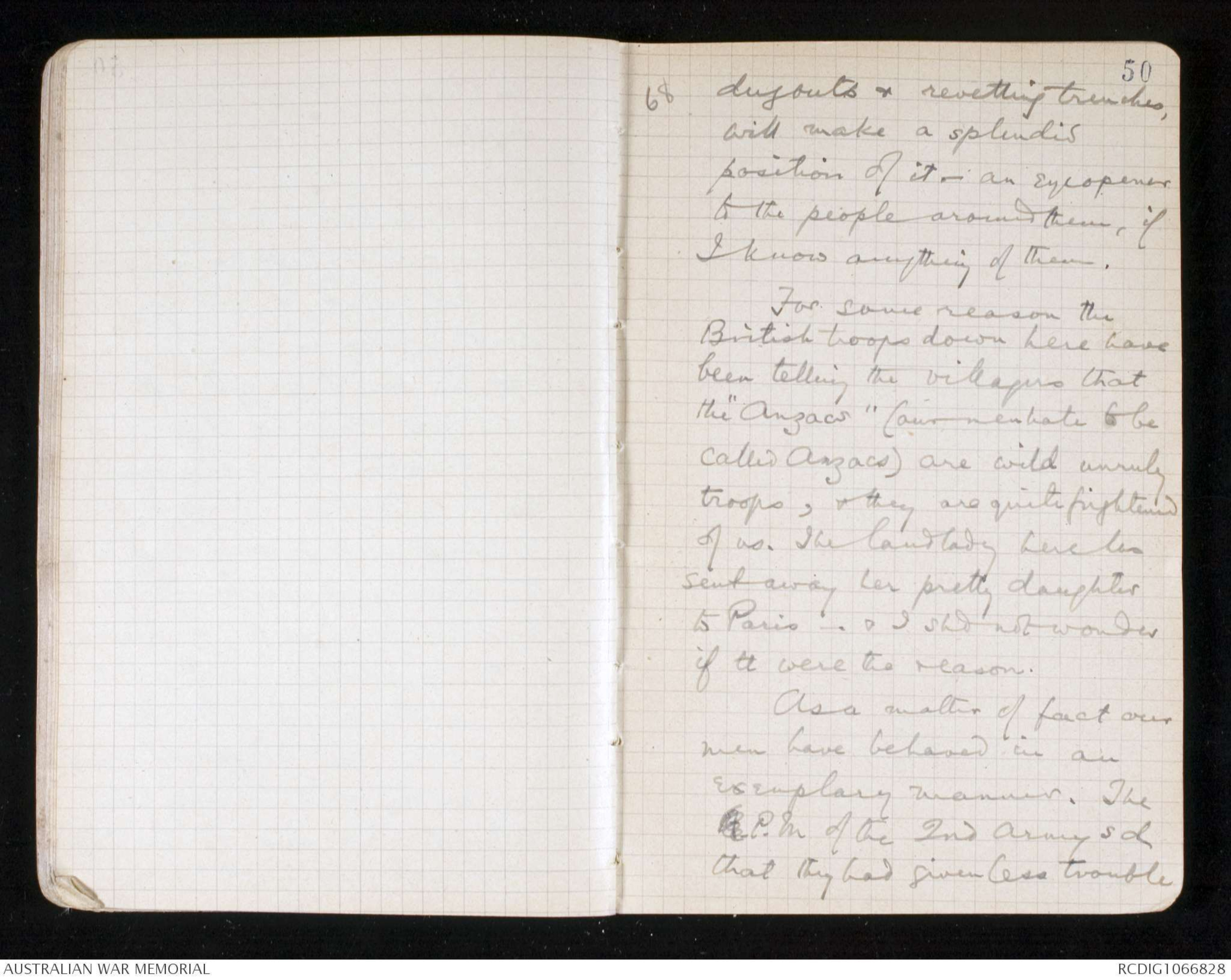
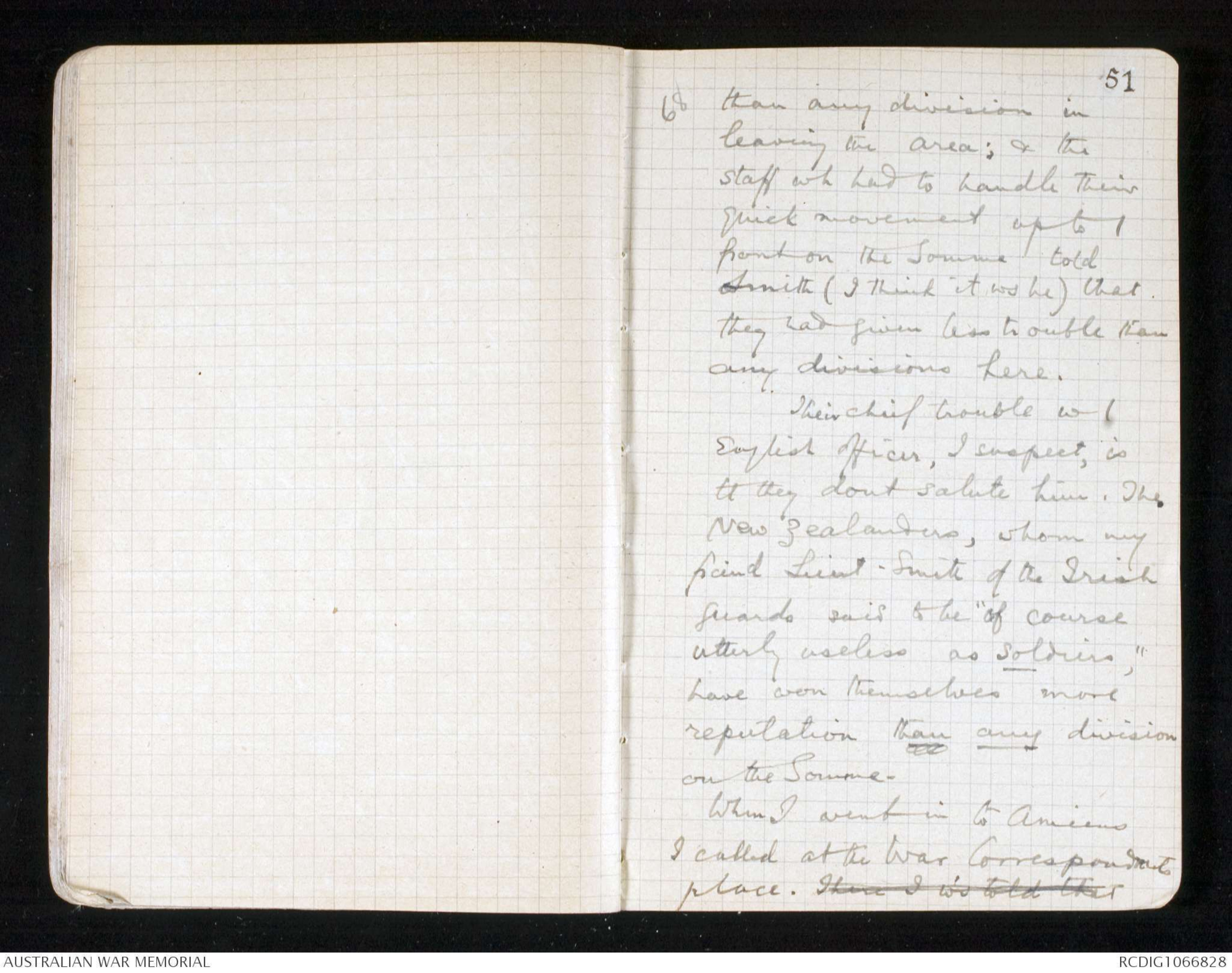

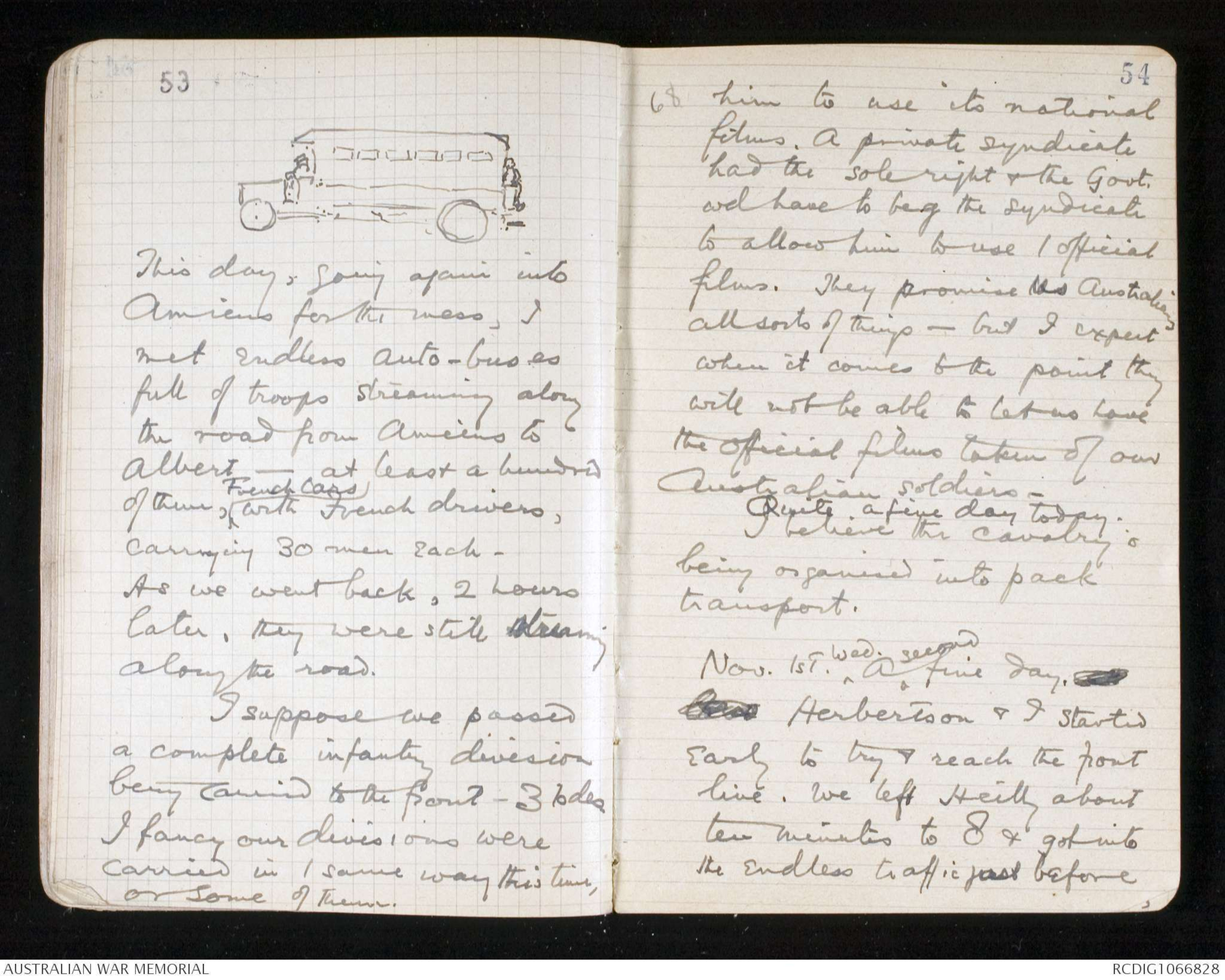
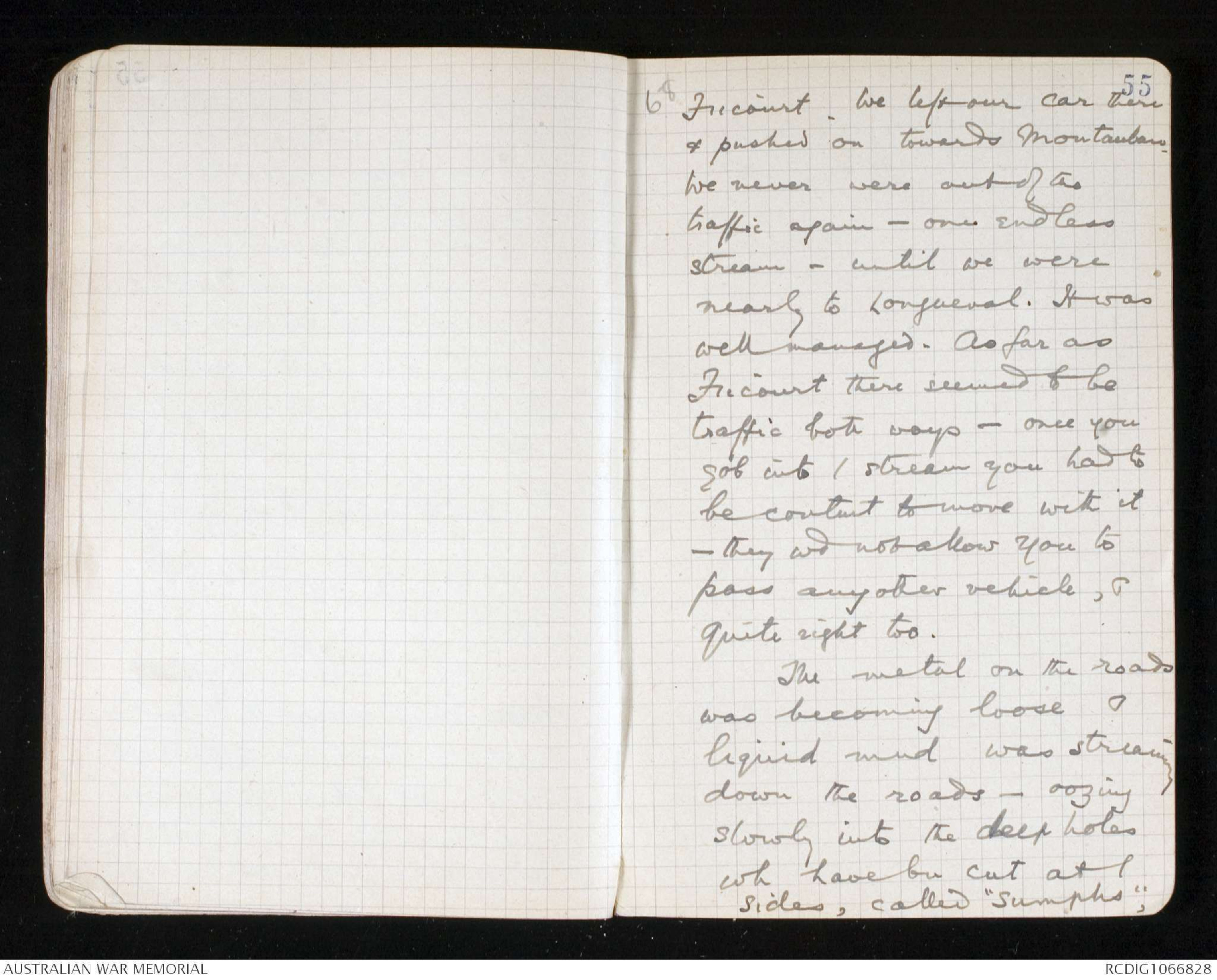
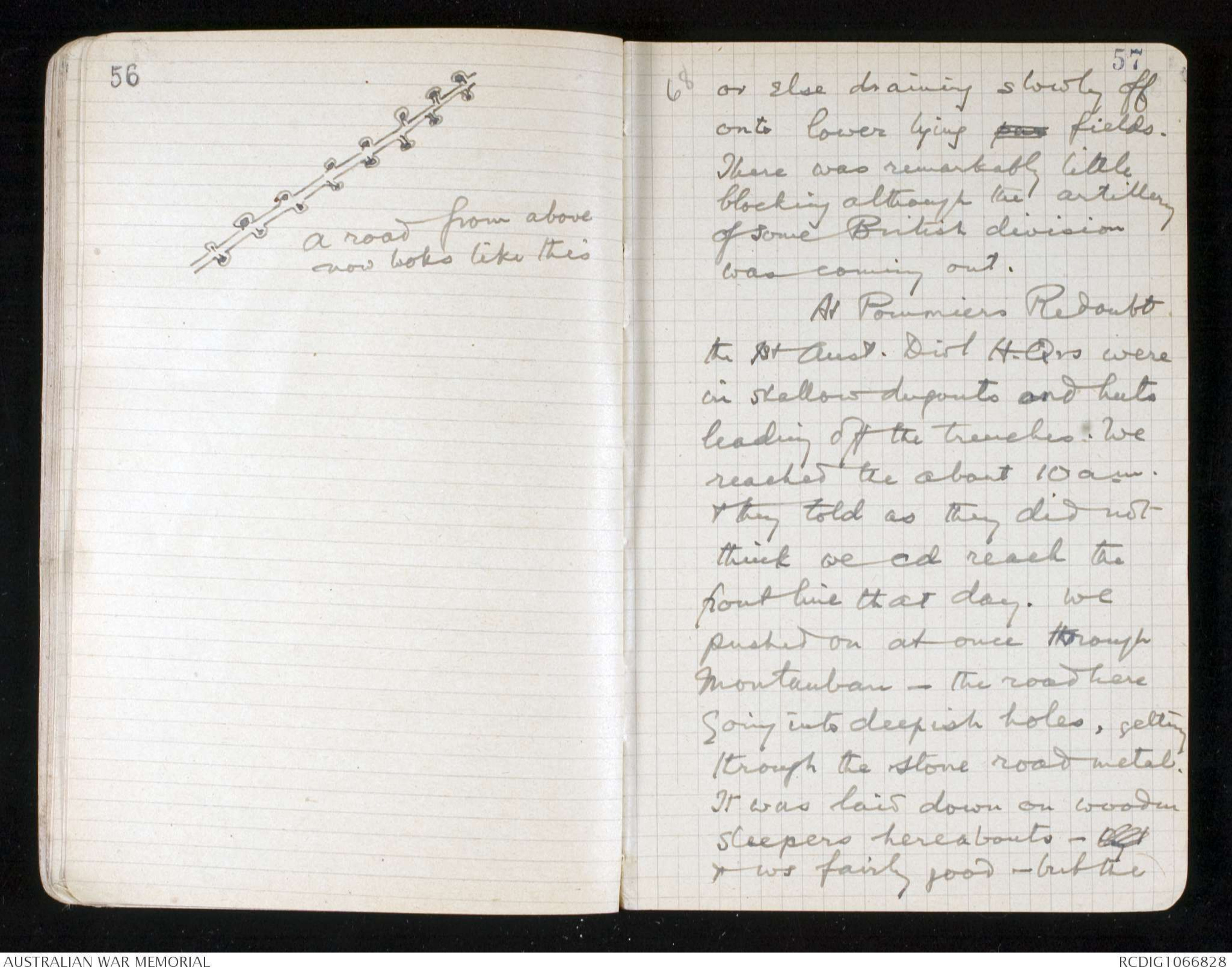
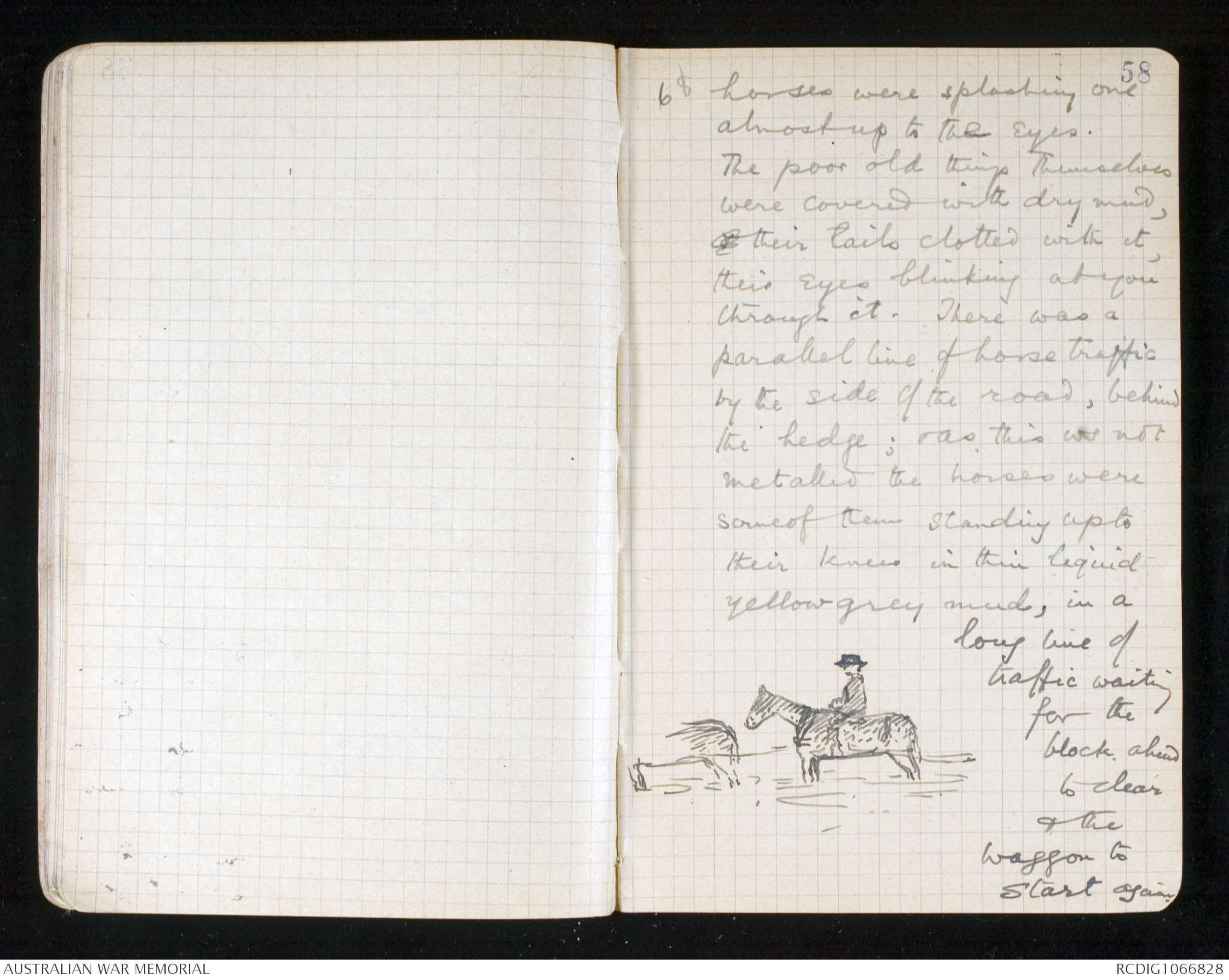
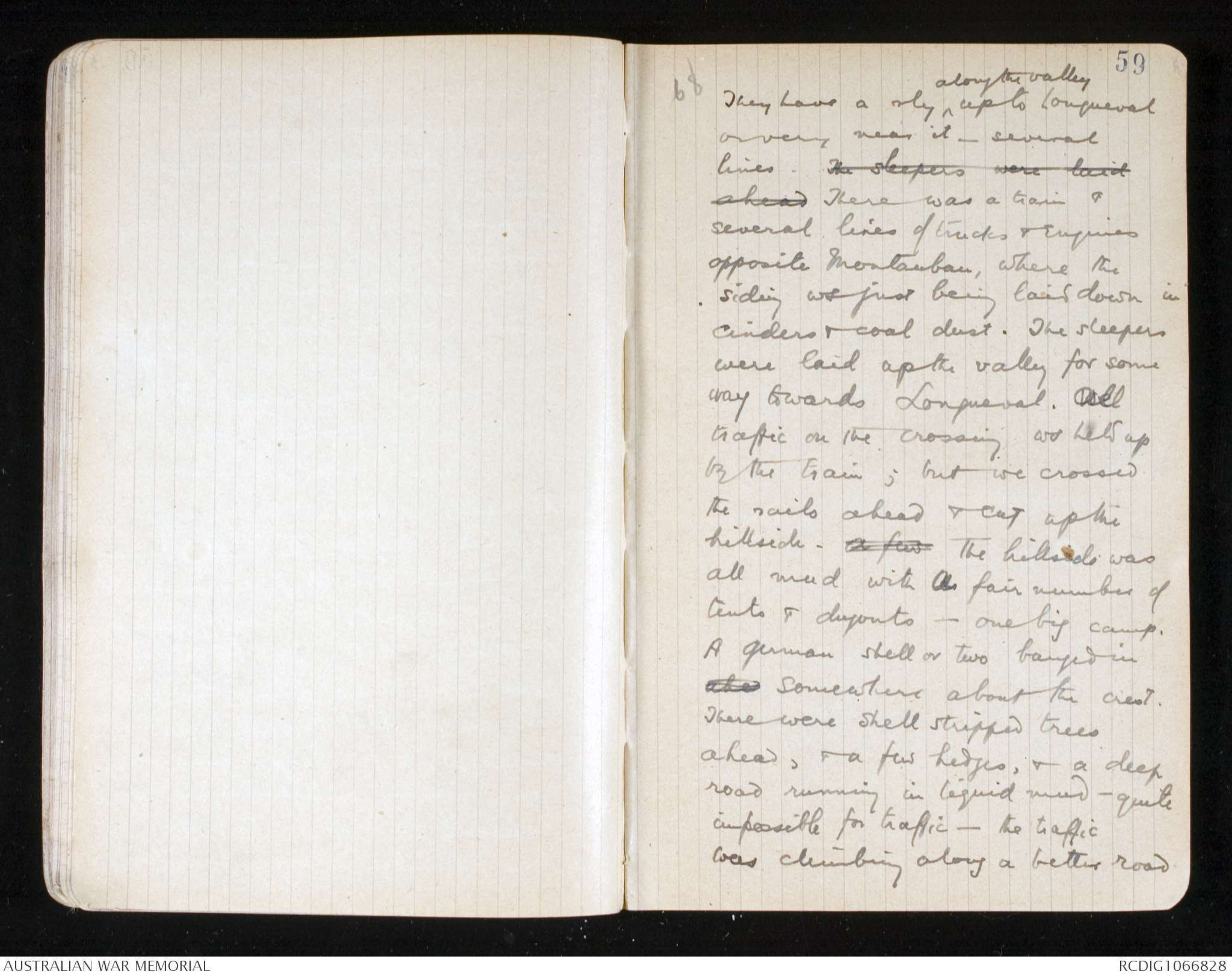
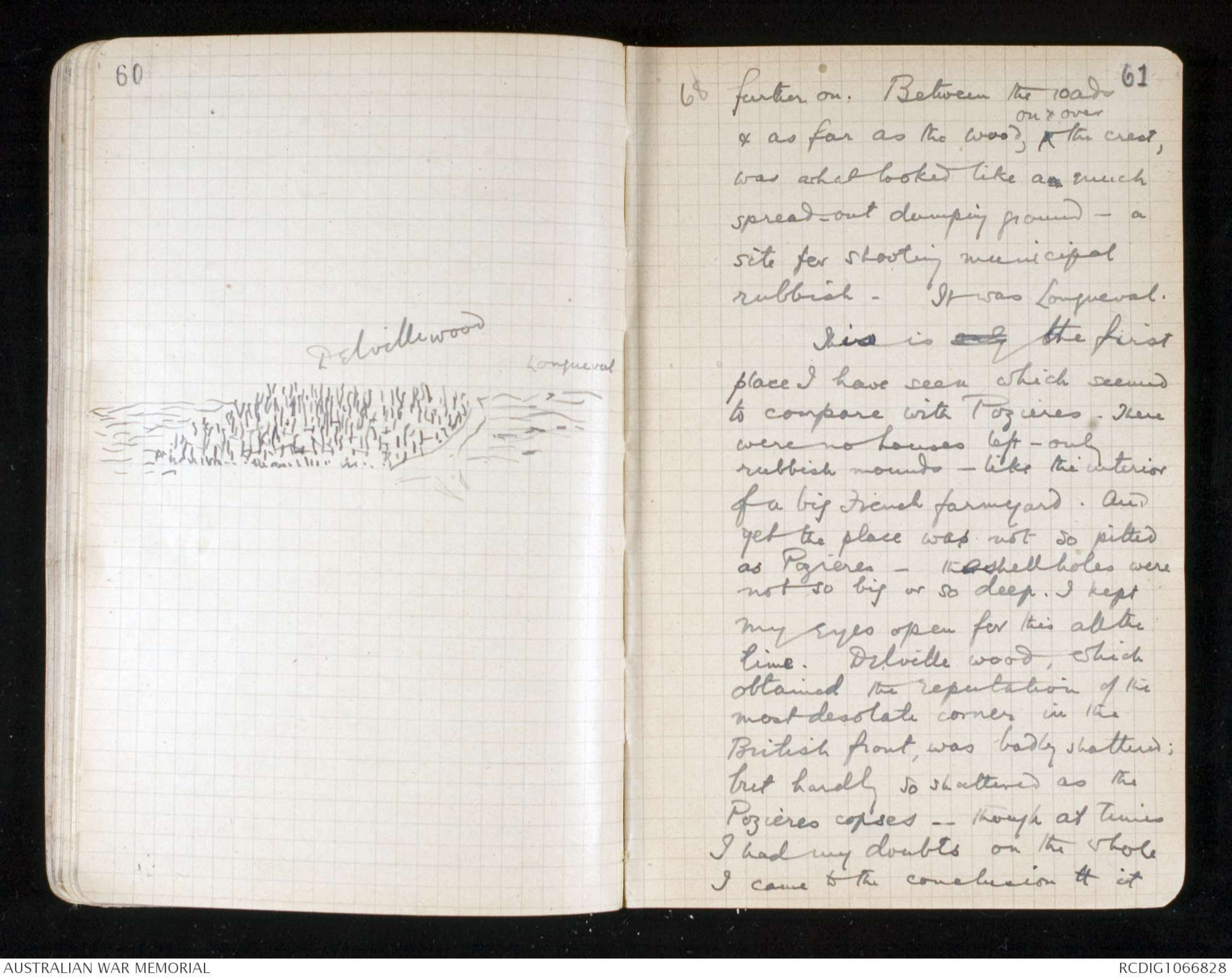
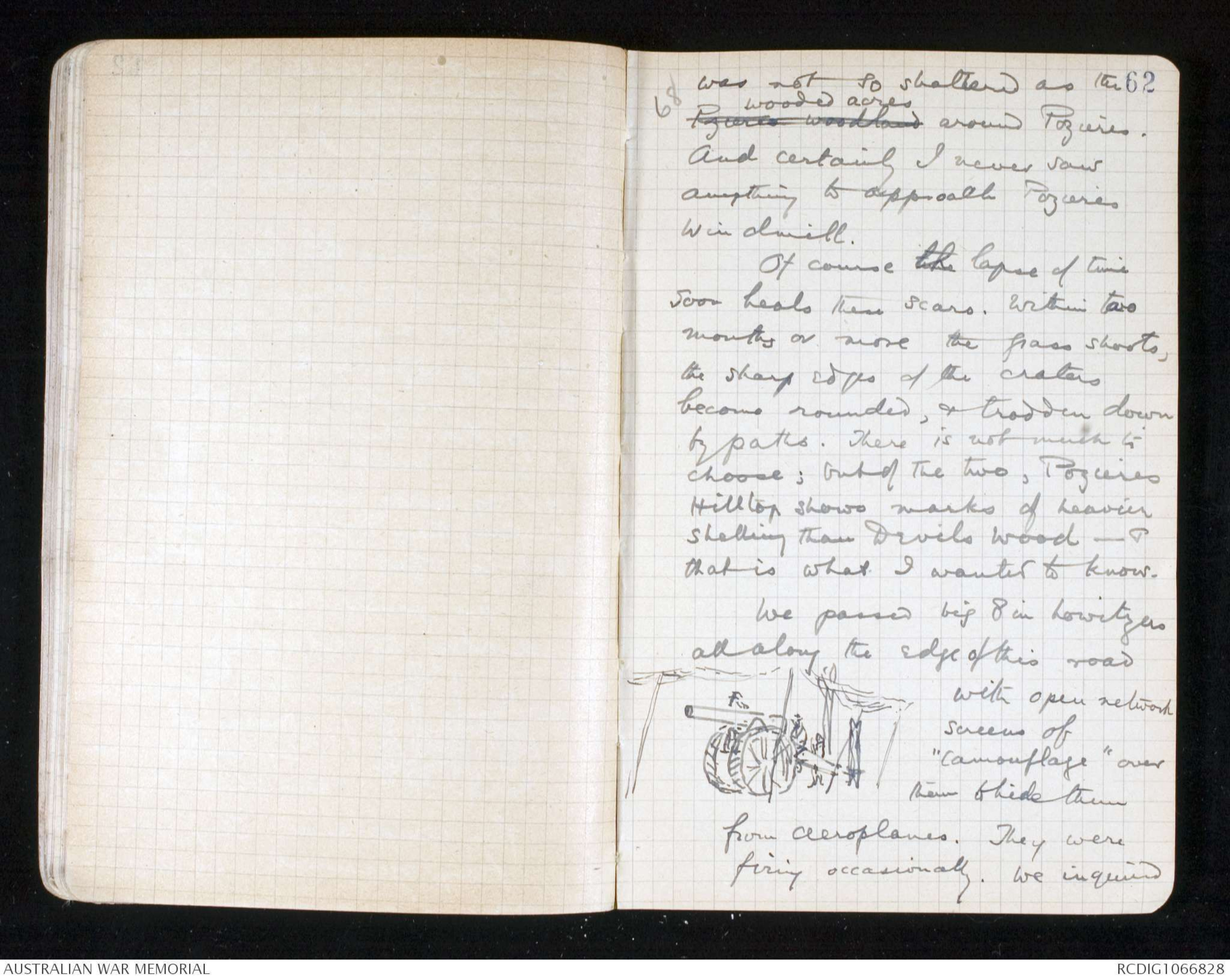
68 50
dugouts & revetting trenches,
will make a splendid
position of it - an eye opener
to the people around them, if
I know anything of them.
For some reason the
British troops down here have
been telling the villagers that
the “Anzacs” (our men hate to be
called Anzacs) are wild unruly
troops, & they are quite frightened
of us. The landlady here has
sent away her pretty daughter
to Paris - & I shd not wonder
if tt were the reason.
As a matter of fact our
men have behaved in an
exemplary manner. TheXx P.M. of the 2nd Army sd
that they had given less trouble
68 51
than any division in
leaving the area; & the
staff wh had to handle their
quick movement up to /
front on the Somme told
Smith (I think it ws he) that
they had given less trouble than
any division here.
Their chief trouble w /
English officer, I suspect, is
tt they dont salute him. The
New Zealanders, whom my
friend Lieut - Smith of the Irish
Guards said to be “of course
utterly useless as soldiers”,
have won themselves more
reputation than any division
on the Somme.
When I went into Amiens
I called at the War Correspondents
place. There I was told that
68 52
Frederick Palmer ws
just abt to leave for America
for the winter. He had engaged
to deliver a series of lectures
on the Somme fighting. He had
just scratched the lectures. And
why?
The egregious British
individualist had given away
the sole right of dealing in
cinema films to a private
concern; to a syndicate of
film manufacturers or
picture producers. When Palmer
asked the war office for leave
to have some of the official
British films, taken by the
official British cinematographers,
the British Govt
had not the power to allow
53
Drawing - see original document
This day, going again into
Amiens for the mess, I
met endless auto-buses
full of troops streaming along
the road from Amiens to
Albert - at least a hundred
of them ^French cars with French drivers,
carrying 30 men each -
As we went back, 2 hours
later, they were still streaming
along the road.
I suppose we passed
a complete infantry division
being carried to the front - 3 bdes.
I fancy our divisions were
carried in / same way this time,
or some of them.
68 54
him to use its national
films. A private syndicate
has the sole right & the Govt.
wd have to beg the syndicate
to allow him to use / official
films. They promise us Australians
all sorts of things - but I expect
when it comes to the point they
will not be able to let us have
the official films taken of our
Australian soldiers -
Quite a fine day today.
I believe the cavalry is
being organised into pack
transport.
Nov. 1st. Wed. ^A second fine day. xxxXxx Herbertson & I started
early to try & reach the front
line. We left Heilly about
ten minutes to 8 & got into
the endless traffic just before
68 55
Fricourt. We left our car there
& pushed on towards Montauban.
We never were out of the
traffic again - one endless
stream - until we were
nearly to Longueval. It was
well managed. As far as
Fricourt there seemed to be
traffic both ways - once you
got into / stream you had to
be content to move with it
- they wd not allow you to
pass any other vehicle, &
quite right too.
The metal on the roads
was becoming loose &
liquid mud was streaming
down the roads - oozing
slowly into the deep holes
wh have bn cut at /
sides, called “sumphs,"
56
Drawing - see original document
A road from above
now looks like this
68 57
or else draining slowly off
onto lower lying par fields.
There was remarkably little
blocking although the artillery
of some British divisions
was coming out.
At Pommiers Redoubt
the 1st Aust. Divl H.Qrs were
in shallow dugouts and huts
leading off the trenches. We
reached the about 10am.
& they told as they did not
think we cd reach the
front line that day. We
pushed on at once through
Montauban - the road here
going into deepish holes, getting
through the stone road metal.
It was laid down on wooden
sleepers hereabouts - xxx
& ws fairly good - but the
68 58
horses were splashing one
almost up to the eyes.
The poor old things themselves
were covered with dry mud, & their tails clotted with it,
their eyes blinking at you
through it. There was a
parallel line of horse traffic
by the side of the road, behind
the hedge; & as this ws not
metalled the horses were
some of them standing up to
their knees in thin liquid
yellow grey mud, in a
Drawing - see original document
long line of
traffic waiting
for the
block ahead
to clear
& the
waggon to
start again.
68 59
They have a rly ^along the valley up to Longueval
or very near it - several
lines. The sleepers were laidahead. There was a train &
several lines of trucks & engines
opposite Montauban, where the
siding ws just being laid down in
cinders & coal dust. The sleepers
were laid up the valley for some
way towards Longueval. All
traffic on the crossing ws held up
by the train; but we crossed
the rails ahead & cut up the
hillside - a few. The hillside was
all mud with a fair number of
tents & dugouts - one big camp.
A German shell or two banged in
abo somewhere about the crest.
There were shell stripped trees
ahead, & a few hedges, & a deep
road running in liquid mud - quite
impassable for traffic - the traffic
was climbing along a better road
60
Drawing- see original document
68 61
further on. Between the roads
& as far as the wood, ^on & over the crest,
was what looked like a x much
spread-out dumping ground - a
site for shooting municipal
rubbish - It was Longueval.
This is only the first
place I have seen which seemed
to compare with Pozieres. There
were no houses left - only
rubbish mounds - like the interior
of a big French farmyard. And
yet the place was not so pitted
as Pozieres - the shell holes were
not so big or so deep. I kept
my eyes open for this all the
time. Delville wood, which
obtained the reputation of the
most desolate corner in the
British front, was badly shattered;
but hardly so shattered as the
Pozieres copses - though at times
I had my doubts on the whole
I came to the conclusion tt it
68 62
was not so shattered as thePozieres woodland wooded acres around Pozieres.
And certainly I never saw
anything to approach Pozieres
Windmill.
Of course the lapse of time
soon heals these scars. Within two
months or more the grass shoots,
the sharp edges of the craters
become rounded, & trodden down
by paths. There is not much to
choose; but of the two, Pozieres
Hilltop shows marks of heavier
shelling than Devils Wood - &
that is what I wanted to know.
We passed big 8 in howitzers
all along the edge of this road
Drawing - see original document
with open network
screens of
“camouflage” over
them to hide them
from aeroplanes. They were
firing occasionally. We inquired
 Loretta Corbett
Loretta CorbettThis transcription item is now locked to you for editing. To release the lock either Save your changes or Cancel.
This lock will be automatically released after 60 minutes of inactivity.